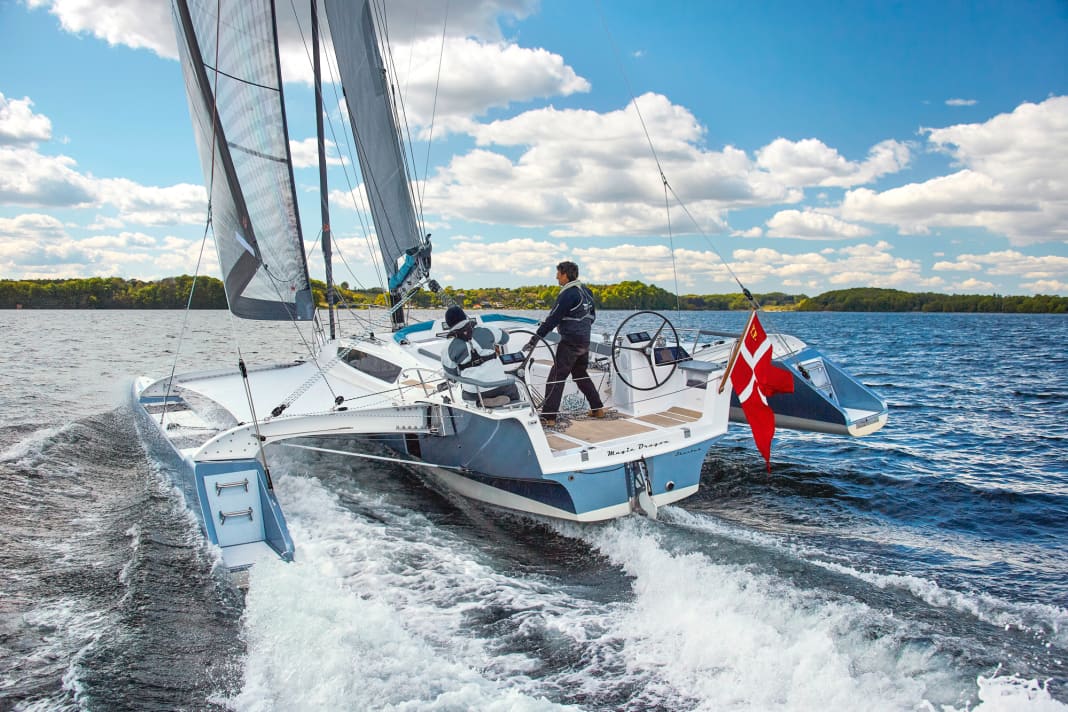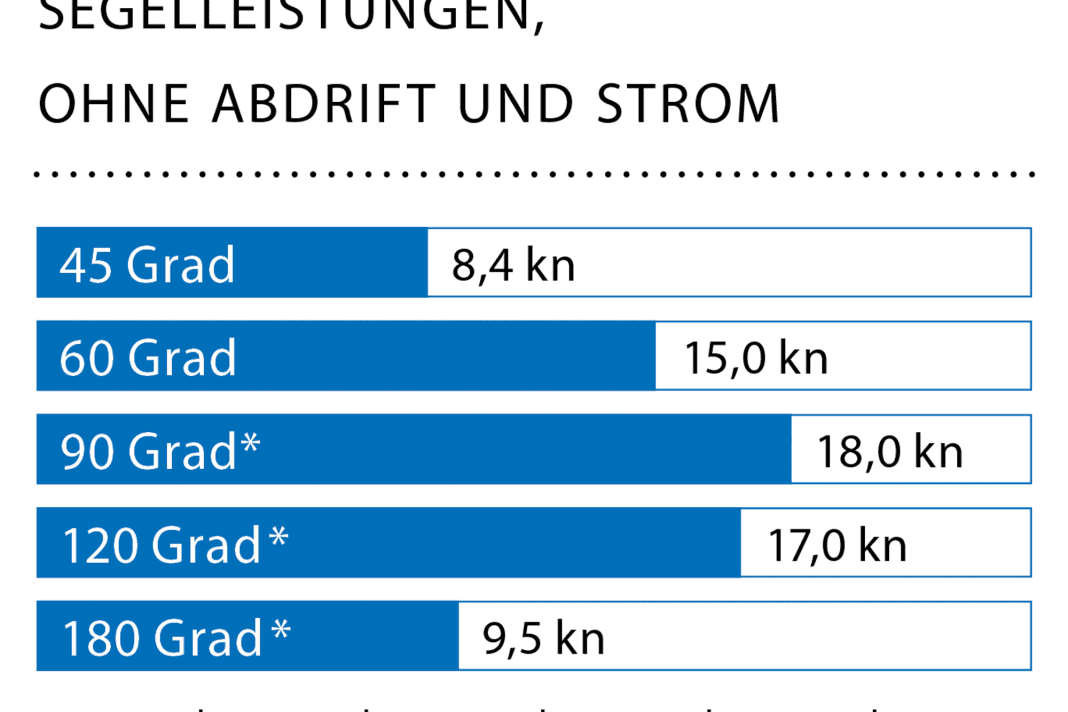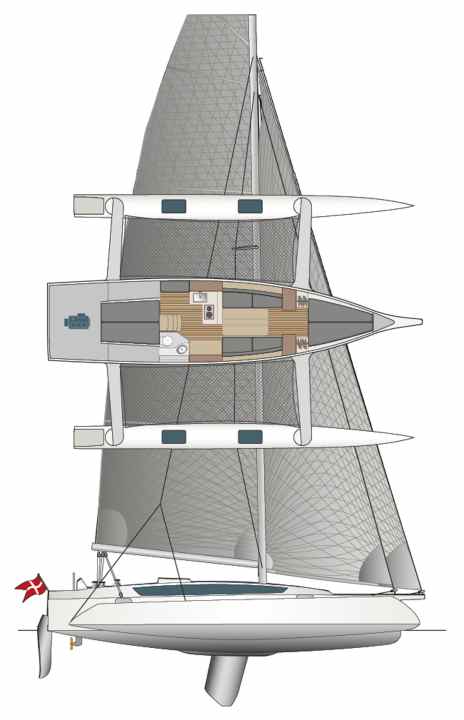





An update on the Dragonfly 40: 25 boats had been sold by spring 2024, a considerable number considering the size and cost. But that's not all: together with Marström Composites in Sweden, Quorning Boats has developed an even more technically complex variant. Around half of the boat is manufactured using carbon prepregs in an autoclave under pressure and heat - the top shelf in modern boat building. In this way, both floats, all four beams, the two main load-bearing bulkheads in the centre hull, the centreboard box and the rudder are produced. These measures reduce the weight of the boat by around 1000 kilograms to just 4.8 tonnes. The centre hull is too complex for this construction method and the autoclave is too small, according to company boss Jens Quorning. He had expected to be able to sell only three to four units of the new hybrid carbon version, but has already been able to win over six customers. And this despite extremely increased costs. This is not only due to the higher carbon fibre part, but also to the new moulds required, which had to be made from solid carbon laminate for use in autoclaves and can withstand 120 degrees Celsius as well as the high pressure. The Dragonfly 40CPerformance costs from 1,095,000 euros including VAT.
Below is the test of the normal versionSilver grey metallic, or in the language of automotive colour theory: lazurite blue. The Dragonfly's paintwork is very unique. What's more, it's a colour that's mainly used for large SUVs. The contrast could hardly be greater, because at 5.8 tonnes, the new twelve-metre-long Dragonfly really isn't a heavy SUV. Admittedly, the vehicle doesn't look very elegant when folded down to four metres. The floats press against the main hull and give the Tri a rather motorboat-like silhouette, especially as there is only a protruding bow and stern pulpit instead of a railing.
The casting off manoeuvre is also similar to that of a motorboat, as the stern of construction number 1 has a whopping 90 horsepower instead of the usual 40 hp. The lavish motorisation weighs only 40 kilograms more and is intended to enable fast cruising, but more on that later. For now, the power makes for a foaming wake. The extendable bow thruster is a welcome help when turning against the strong crosswind, as the Tri hardly dips and therefore has little lateral surface area, but is over 14 metres long when folded. Once under way, the centreboard and rudder work very well and the Dragonfly is very easy to manoeuvre.
Things get exciting again outside the harbour. The vessel has to be unfolded for sailing. In fact, the manoeuvre is limited to opening two halyard stoppers on each side and briefly using the standard E-winches. To increase the stability of the Tris, the floats are pushed deeper into the water when folded; their buoyancy therefore helps when unfolding. Only the last few metres of the endlessly sheared operating line have to be pulled through using the electric winch. The whole process takes less than a minute. Finally, the backstays are pushed through and the rig is tensioned with them.
The competition of the Dragonfly 40
As soon as the mainsail is set on the 2:1 halyard, the fun begins. The test boat is the Ultimate version with a higher rig, better equipment and an overlapping headsail. The squarehead main alone brings 75 square metres to the wind. The genoa provides a further 38, and the Code Zero has an area of 80 square metres. In the tamer touring version, the main and self-tacking jib together measure 90 square metres.
With no braking ballast and the enormous stability of the 8.40 metre beam, the wind energy is instantly converted into speed - sometimes an unusually dynamic undertaking in 14 to 22 knots of wind. You've just enjoyed the almost double-digit speed when a push catapults the Tri forwards and the logs rush upwards. Apart from the pure acceleration, little of this is noticeable; unlike a monohull, the heeling practically does not increase.
20 knots are easily reached
Only the rudder pressure seems disproportionately high for the first few miles. Designer and shipyard boss Jens Quorning quickly found the solution: The retractable rudder is not in the lowest position. Shortly before the test, the system was checked and the downhaul was probably not fully pushed through; small cause, big effect. With the correct blade position, the Tri hangs on the handlebars like a go-kart. The direct response to steering commands is also necessary, at least if you want to utilise the Dragonfly's full potential in gusty weather.
The rapid changes in speed require equally rapid and courageous course corrections in order to follow the apparent wind. This becomes particularly clear under Code Zero. The Tri carries the additional 80 square metres of cloth without any problems. As long as the wind doesn't drop too much, the log almost always shows 17 knots or more. As soon as the water surface upwind turns a telltale dark colour and announces a gust, it's time to drop off. 18, 19, 20 knots, the picturesque landscape of the Little Belt flies by and requires frequent gybing.
The lack of a traveller is noticeable here. So that the almost rectangular mainsail can also be trimmed to leeward without a carriage, an auxiliary tackle is rigged on the lee beam in addition to the sheet. Although the twist of the sail can be easily adjusted with the two tacking buoys, the auxiliary tacking buoy has to be taken off before every manoeuvre and attached again on the new bow - a bit tedious in narrow waters, so you will probably have to do without the perfect sail trim in touring mode.
The Dragonfly 40 accelerates enormously - but sails in a decidedly unagitated manner
It's also annoying that we have to return to our home harbour, because that means cruising. Not that the Dragonfly doesn't go upwind, quite the opposite. Thanks to the low water resistance and the very small sheeting angles, turning angles like a monohull are possible, and still at significantly higher speeds. The boat usually logs between 8 and 9 knots.
However, the helmsman must steer very carefully. The neutral but direct layout requires full concentration, as it offers little feedback, and the sails, which are cut flat for high speeds, are hardly forgiving of wrong currents. In other words: the Tri sails well, but if the helmsman is not fully focussed, it is easy to miss a knot or the boat sails 10 degrees too low.
There is little to worry about when tacking. As the floats hardly dip into the water without sail pressure, the Dragonfly turns very well through the wind. "If there's a lot of wind and waves, we recommend feathering the mainsheet slightly before tacking so that the sail doesn't exert so much pressure and the boat picks up speed more quickly on the new bow," says tri pro Quorning.
Light & safe
The floats offer a great deal of buoyancy and therefore large safety reserves, whether at the cross or during a space sheet ride. Even in heavy pushes, the boat builds up speed instead of diving away. This should not change even with a full holiday load. According to the shipyard, 1.8 tonnes can be loaded. This means that even a fully equipped Dragonfly weighs around 500 kilograms less than an empty monohull of comparable length, such as an X 4.0.
And this despite the fact that the shipyard only uses carbon fibre for the mast profile. The hulls are laminated by hand. Wherever possible, Divinycell sandwich is used, and the required laminate thicknesses are precisely calculated. As no keel forces have to be introduced, the structure looks completely different to that of a monohull. Enormous loads occur in the area of the forward beams in particular. For this reason, there is no square door in the passageway to the forecastle, only an oval opening. "The bulkhead has to withstand up to 25 tonnes of pressure," says Quorning. "We can't make a larger hole." The beams are also subjected to extreme loads; they are laminated in an infusion process under vacuum and then annealed.
Plastic parts and rig manufactured in our own workshop
To ensure the desired lightweight construction and quality, the shipyard manufactures the plastic parts itself. Quorning Boats has a total of five sites in and around Skærbæk. Dismantling and final assembly also take place there, at the shipyard's headquarters. To prevent deformation, the hulls are stored in precisely fitting negative moulds.
Even the rigs are produced in the company's own workshop; only the bare carbon fibre tube is manufactured by a supplier. Standard masts with a teardrop-shaped profile are out of the question for Quorning. "Our round masts have less wind contact surface, which is important in extreme crosswinds and with folded floats," explains the shipyard boss.
On the last few miles to the harbour, the engine has to be tested. Theoretically, the powerful engine should be sufficient for comfortable cruising beyond 11 knots. The shipyard had already trialled this concept on the predecessor model, the Dragonfly 1200. However, the set-up on the 40 is not yet perfect. When accelerating, the powerful diesel engine pushes very hard, but the cruising speed of around 8 knots is hardly any higher than would be expected with the standard engine, which is half as powerful, and this results in strong vibrations.
Quorning is also not satisfied with this result. His assumption: the engine power requires a very large propeller, the distance between it and the fuselage is too small. This causes turbulence and eats up power. A longer saildrive should solve the problem. Falling dry should also not be a problem with the drive projecting further downwards.
More space than expected below deck
The shipyard boss is proud of the 40's space utilisation. The living space below deck on trimarans is usually tight, as only the slim centre hull is inhabited. The Dragonfly is no exception to this rule, but the bulkhead shape of the main hull significantly increases the usable volume. While the underwater hull is slim and sharply cut as before, the width above the waterline increases abruptly, creating more space. A positive side effect: the step in the side wall acts as a water deflector, so the Dragonfly sails dry even at high speeds.
The layout corresponds to the classic monohull standard with an aft cabin. This was not previously the case with Dragonfly: either the aft berth was open to the saloon as on the 35, or it was completely separate and only accessible from the cockpit. Surprisingly, although the cabin is under the cockpit, it offers a pleasant amount of headroom. The obligatory escape hatch provides a view of the sea, and a deck hatch lets additional light into the cabin. The corner-opening wardrobe with compartments integrated into the door is a clever solution.
The rest of the ship is also bright. In the saloon, the wide window strip and three large deck hatches provide daylight. The hull windows installed in the test boat are also available on request. The side windows in the foredeck are standard.
Classic room layout with excellent workmanship
The integration of the centreboard box is a good solution; it replaces the table base and extends under the pantry block, so the massive component hardly interferes. The high seating position, on the other hand, is unconventional. In order to utilise the additional width of the hull, the saloon bays are unusually high. This means that the feet on the starboard side have no contact with the floor. A footrest can therefore be folded out for comfortable seating.
Overall, the interior fittings leave a very good impression. The woodwork, with its many moulded coamings and edgings, is just as flawless as the silk-matt paintwork. The gaps are perfect and the grain of the unusual elm veneer is beautifully harmonised. Quorning thus presents a level of maturity that is rarely found in prototypes.
However, the price is also in a class of its own. Even the 785,800 Euro for the basic boat are not favourable. If you look at the price per knot, the calculation looks better, because even a Shogun 50, which is twice as expensive, does not sail nearly as fast with a small crew, not to mention the maintenance costs of the 50-footer.
The measured values for testing the Dragonfly 40





The Dragonfly 40 in detail

Technical data of the Dragonfly 40
- Designer: Quorning/Olsen
- CE design category: A
- Torso length: 12,40 m
- Total length/folded: 12,40/14,17 m
- Waterline length: 11,50 m
- Width/folded: 8,40/4,00 m
- Depth: 0,70-2,20 m
- Weight: 5,8 t
- Ballast/proportion: 0,0 t/0 %
- Mast height above waterline: 20,75 m
- Mainsail: 75,0 m2
- Furling genoa (110%): 38,0 m2
- machine (Yanmar): 27 kW/40 hp
- Fuel tank: 150 l
- Fresh water tank: 220 l
- Holding tank: 75 l
Hull and deck construction
GRP sandwich with Divinycell and vinyl ester resin using the hand lay-up process, beams and bulkheads laminated using the vacuum infusion process, tempered
Equipment and prices
- Base price ex shipyard: 865.000 € gross incl. 19 % VAT.
- Standard equipment2 included: Engine, sheets, railing, navigation lights, batteries, compass, cushions, galley/cooker, bilge pump, toilet, sailcloth, anchor/chain, fenders, mooring lines, fire extinguisher, electric cooler, holding tank with suction system
- Also included in the price: Four electric winches, AGM consumer batteries with 300 ampere hours capacity, carbon mast, mast slide system, mainsail and self-tacking jib as Epex membrane, folding propeller
- Guarantee/against osmosis: 2/5 years
As of 02/2024, how the prices shown are defined can be found here!
Shipyard and distribution
Quorning Boats Aps, Skærbækvej 101, 7000 Fredericia/Denmark; Tel.: 0045/75 56 26 26; www.dragonfly.dk
YACHT review of the Dragonfly 40
The Dragonfly enables enormous average speeds without demanding the crew and offers an astonishing amount of space below deck. The folding mechanism allows the Tri to shrink in the harbour. That makes it unique. The workmanship is exquisite, but so is the price
Design and concept
- + Solid construction
- + Sophisticated folding system
- + Variable draught, can fall dry
Sailing performance and trim
- + Good crossover properties
- + Very high cruising speed
- - Cumbersome traveller replacement
Living and finishing quality
- + Very good workmanship
- + Very good utilisation of space
- + Elegant mix of materials
Equipment and technology
- + Very high-quality equipment
- + E-winches as standard
- + Comprehensive basic equipment
This article first appeared in YACHT issue 14/2020 and has been revised for this online version.

